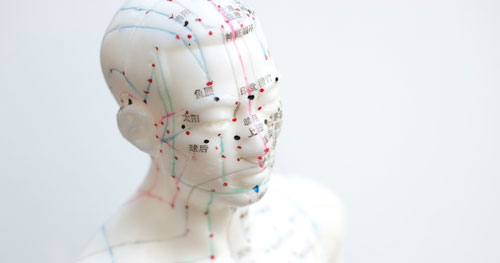In Practice: Integrative Medicine with Dr. Lawrence Li

By Claire Hutkins Seda, Writer, Migrant Clinicians Network, Managing Editor, Streamline
“I got into [integrative medicine] treatment not because of curiosity,” but because of a personal injury, explained Lawrence Li, MD, MPH. It started when Western treatments failed to heal his ankle, which was still swollen six months after a cross-country ski accident, Dr. Li explained. “When I have pain, I’m very hungry to learn what I can do to make it better. I have a very flexible attitude, and I’m curious, too.” A cousin recommended acupuncture, and his ankle injury diminished. Soon after, Dr. Li began acupuncture training. It was the start of a turn in Dr. Li’s professional path, in which he tries to weave alternative treatments and perspectives into his patient-centered medical approach as a physician for underserved patients in Lompoc, California. Dr. Li’s initial exploration in acupuncture led him to new and varied therapies, including acupressure with ear seeds, meridian tapping techniques, certain preferred stretches (which he says are a hybrid of physical therapy and yoga), and, most recently, Feldenkrais. Many but not all patients have been receptive to these types of therapies over the years, and Dr. Li reports that his approach has merit for some patients.
“I’m a pragmatist,” Dr. Li explains. “If there’s something simple that we can do medicine-wise that we know will work, then we’ll do that,” but when it doesn’t work, he is interested in exploring other avenues. He gives the example of a patient with chronic pain. Medicines may ease the pain but not solve the underlying issue. Common approaches like physical therapy don’t work for all patients. “There is no pain specialist that can solve all chronic pain [issues],” he notes. He tells suffering patients, “‘There’s not a simple answer for what you have, but we should keep looking for different kinds of things’… That seems like the most practical approach.”
None of the alternative approaches are required, said Dr. Li. “In a sense, [the patients] choose. I just give them more than one option.” Dr. Li finds that multiple sessions with the patient can be useful, although not always necessary — but teaching or administrating new approaches does take time in the exam room, a serious point of friction, when practitioners are already overloaded and the schedule is tight. This is particularly challenging with migrant patients, who may arrive at a clinic with one health concern, and a whole backlog of other concerns that have gone unaddressed as they move from one location to another, or because of their inability to access care. On the flipside, migrants may come from a cultural background where integrative medicine’s frequent inclusion of non-Western approaches is accepted and preferred — and those patients may be more comfortable with, and even be seeking alternatives like traditional medicine. Even when Dr. Li doesn’t promote the healing methods a patient prefers, it’s important to encourage that conversation, he says. An integrative approach allows for a greater understanding of a patient’s health beliefs, which may lead to better patient buy-in for the eventual treatment. For example, “Mexican migrant farmworkers may have faith in traditional healing with curanderos, [or] herbal remedies. I’m not well-versed in traditional Mexican medicine but understand some of the specifics enough to identify which patients have strong beliefs,” he noted, which is an important starting point. A central part of his approach, he says, is recognizing that every patient, regardless of background, comes with his or her own set of beliefs. “My personal emphasis is less on the exotic cross-cultural differences and more on understanding my patients and establishing rapport,” Dr. Li emphasized. “When I model attentive listening, and respect for their viewpoints and values, then my patients will trust me more, even when we disagree on how to proceed with diagnostic and treatment plans.” He has encountered different levels of support from staff, fellow physicians, and executive staff and boards of directors; some have encouraged his work, while in some settings, he has had to limit his alternative therapies. Despite some challenges, Dr. Li believes he is a better doctor because of his willingness to try something outside of the mainstream. He notes that while some of the therapies he uses don’t necessarily require years of study on the physician’s part, they do require some hands-on skill building to gain basic proficiency in the chosen modality. But getting started can be challenging. Dr. Li recommends the Integrative Medicine for the Underserved’s annual conference as a way for clinicians to connect with others interested in exploring new approaches for patients, and to learn basic skills and how others use them. State practice rules and regulations may limit providers’ uses of alternative therapies in the exam room without designated education or apprenticeships. IM4U may be a useful avenue for determining where caution is needed and how to best navigate the world of integrative medicine among underserved populations.
Now Dr. Li is enthusiastically working with a different therapy he has recently encountered, the Feldenkrais Method (www.feldenkrais.com), which focuses on developing a patient’s kinesthetic and proprioceptive self-awareness of his or her basic movements to reduce pain. He again came to it when other approaches — including other alternative approaches like acupuncture, yoga, and massage — had failed in healing a more recent injury, a debilitating flare-up of sciatica. His pursuit of yet another treatment falls nicely into Dr. Li’s outlook on medicine, to never stop learning, to remain curious, and to try new things when all else fails.
Read this article in the Summer 2016 issue of Streamline here!
Sign up for our eNewsletter to receive bimonthly news from MCN, including announcements of the next Streamline.
Return to the Streamline Summer 2016 Table of Contents.
